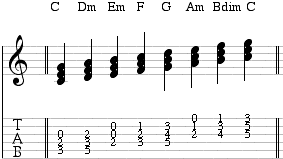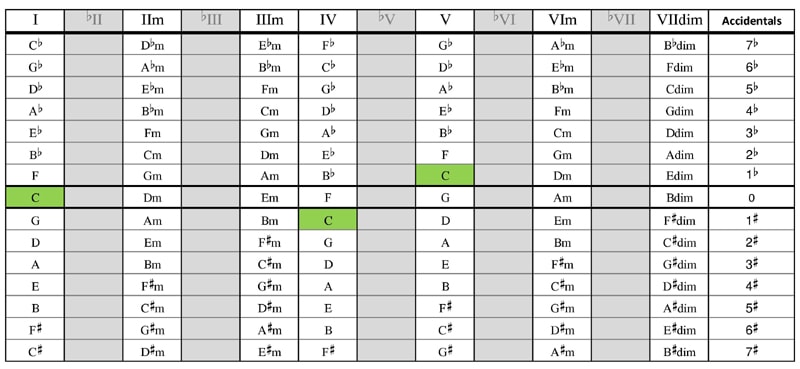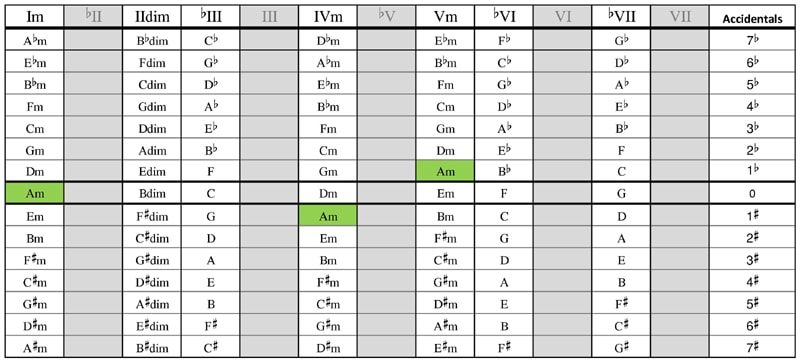Chord progressions are a series of guitar chords played in a set sequence on a scale, that establish a tonality founded on a key. They usually consist of 2,3 or 4 chords.
Chord progressions are the building blocks of every modern song, so understanding what they are is very important to learning guitar. Once you understand how chord progressions are created, you'll be able to create them in any key you want.
To fully understand how you can build guitar chord progressions, you need to be familiar with guitar scales and chord theory.
If you are, great!
If not, you might want to consider revising the topics. Beginners learning chord progressions get a bit anxious when they find out that they need to know theoretical stuff, but don't worry, chord progressions are easy if you understand the basics.
Chords on a Major Scale
As always, it's best to learn by doing, so let's have a go at how to build chord progressions by using examples. As I mentioned before, you'll need to know guitar scales, if not all, at least the major scale.
All scales contain 7 musical notes, and finding the right chord progression in a given key is just a matter of calculating the chords on a given scale.
Let's recall the major scale intervals:
1 W 2 W 3 H 4 W 5 W 6 W 7 H 1
W = whole step (or 2 fret interval)
H = half step (or 1 fret interval)
Now let's use the C major scale for our example, meaning will be in the key of C. (You can apply the major scale intervals to any note, thereby changing the key you're playing in.)
C W D W E H F W G W A W B H C
The notes in the C major scale can also be used to play chords along the scale. You can get the notes for each chord by harmonizing the scale, which we'll cover in another lesson separately.
For now, just remember that the 1st, 4th and 5th chords of a major scale chord progression will always be major chords (indicated by capitalized roman numerals), while the 2nd, 3rd, and 6th chords will always be minor (lower roman numerals). The 7th chord is a diminished chord, but you can also use a minor chord. Whichever sounds good.
Again, this is for chord progressions in a MAJOR key.
So if you wanted to play every chord in the key of C, you'd play the following chords:
C W Dm W Em H F W G W Am W Bdim H C
where:
- C is the one chord- I (Major)
- Dm is the two - ii (minor)
- Em is the three - iii (minor)
- F is the four - IV (Major)
- G is the five - V (Major)
- Am is the six - vi (minor)
- Bdim is the seven - vii (diminished)
Notice the distinction between the CAPITALIZED chord numeral, and the lower case one (ie. capital "I" vs lowercase "ii"). Whenever you see this, it'll mean that:
- the capitalized chord is major,
- the lower case chord is minor
That's a basic rule of thumb.
So let's get back to our example.
If you want to keep the ascending nature of chord voicings, you won't be playing the regular open string chords as you've learned before, but in a way where the lowest note of any chord will always be higher than the lowest note of its preceding chord.
So in the case of our C major chord scale, you'd play these variations of chords if you wanted to keep the ascending tonality:
The above might be new to you, but it's straightforward chord theory. Chords are made up of set notes, meaning that you can play a C chord for example in several places on the fretboard, allowing for different voicings of chords.
Of course, you don't need to keep this ascending nature of chord voicings, you can play the open string chords as well.
Learn Popular Chord Progressions on Guitar
Now that you are familiar with the chords in the key of C, you can start playing chord progressions using its chords.
Here are a couple of popular chord progressions in C major. Again, keep in mind that the 1st, 4th, and 5th chords are major, and the 2nd, 3rd, and 6th chords are minor.
- I - V (C - G)
- I - vi - ii - V (C - Am - Dm - G)
- I - IV (C - F)
- I - vi - IV - V (C - Am - F - G)
- I - vi (C - Am)
- I - vi - ii - vii (C - Am - Dm - Bdim)
- I - IV - V (C - F - G)
- I - vi - IV - vii (C - Am - F - Bdim)
- I - ii - V (C - Dm - G)
- I - vi - V (C - Am - G)
Major scale chords in all keys
Even beginner guitarists can play any kind of chord progression they want in any key, since it's just a matter of substituting the notes of the chosen key, and learning the chords required to play a progression.
So go ahead and apply the above chord progressions to different keys by transposing them.
Map out the chords in the given key using the intervals of the major scale, and play the chords as in the above example.
For example, the progression I - IV - V in the key of A would be A - D - E, while in the key of C, the chords will be C - F - G. Once you know the formula for the progression itself, you can find the chords to play along the chord scale.
Here is a nice little chart to help you out, C is highlighted just to give you a reference point:
Minor scale chords in all keys
The above table was specific to major scale chords, but if you wanted minor chord progressions, you would first of all need to specify what chords are in the given key, based on the minor scale intervals:
1 W 2 H 3 W 4 W 5 H 6 W 7 W 1
The order of chord qualities is different as well. The minor scale starts off of the 6th note of the major scale, so these are the chord qualities you would use for minor scale progressions:
- i - minor
- ii - diminished
- bIII - major
- iv - minor
- v - minor
- bVI - major
- bVII - major
And here is a table to make things a bit easier. Am is highlighted just to give you a reference point:




Thank you so much for this course, it is absolutely fantastic! I used to play the piano for 7 years in a very classical way with 8 years of solfege and been slowly transitioning to the guitar one year ago. I’ve learnt the most common chords used in rock and blues and been mostly playing by ear, but all those numbers and guitar tabs were very abstract compared to a piano music sheet. So far, I was playing without really understanding what I was doing but it ALL MAKES SENSE now!
I am confused. You have C W D W E H F W G W A W B H C and then for the chords you have C W Dm W Em H F W G W Am W Bdim H C.
Why is a whole step a D in notes an a Dm in chords? Isn’t that a half step not whole after the C?
Thanks
No, you are mixing up D minor with D flat (Db).
– Db is another note on the musical alphabet, which would be just a half step away from C. D flat is not in the key of C at all.
– D minor is the character of the chord (minor), derived from the note D, which is in the key of C (1 whole step away).
I hope that makes sense.
Yes I think I do. As I am sure you can tell I am just delving into theory.
Thank you for your help
Taking the C scale: The first,(I),fourth (IV) and fifth (V) notes of the scale (To remember:positions 1,4,5) give the name to the Major chords of the scale,
while the second(ii),third (iii) and sixth(vi) (Positions 2,3,6) give the name to the minor chordsof the scale.Now,to find the notes of which each chord major or
minor is consisted of,you apply the triad rule 1-3-5,i.e. for C chord the notes are C(root) ,E (third), G(fifth) i.e C-E-G,for Dm say: D,F,A e.t.c.
Did it help?
Are you saying that, for example, in the key of Am, the only chords that may be used are C, Dm, Em, F, G, Am, and Bdim?
i.e., chords like Cm, D, E, Fm, Gm and A (and their sharped or flattened versions) won’t ever (except on rare occasions) sound right?
Yes, if you are playing the key of A minor, only the chords you listed will sound right. It is the same with every key. That’s how music works, sort of like mathematics. This may feel limiting, but remember that there is almost an infinite way of playing each chord higher or lower on the neck, you can add variations to each chord like a 7th degree note, etc, and the style in which you play will fundamentally alter the feel of the song.
Understood.
So if I play those chords higher or lower on the neck, I don’t have to worry about my pitch conflicting with the pitch of the song?
Are there guidelines on when to use (or not use) extended chords?
Thanks for your reply,
Dan
That is correct. You can play a given chord anywhere on the neck, the CAGED system is a lot of help in this.
You can use extended chords whenever you like. Regular chords can get a bit boring, but adding a 7th, a SUS, or extra notes here and there can make things much more interesting. These are called chord embellishments.
It appears you have an error on this page. You wrote:
So if you wanted to play every chord in the key of C, you’d play the following chords:
C W Dm W Em H F W G W Am W Bm H C
In the ascending tonality section, you list Bdim instead of Bm.
Did you meant to write:
C W Dm W Em H F W G W Am W Bdim H C??
Yes, thanks for catching that, the 7 chord in a major scale chord progression is supposed to be a diminished chord.